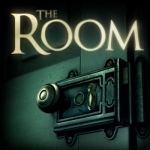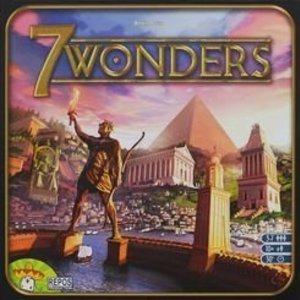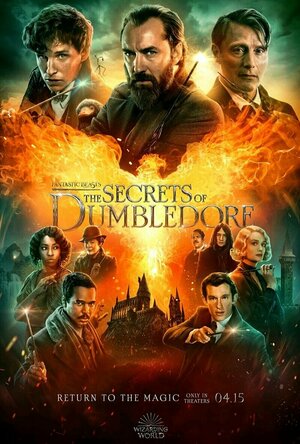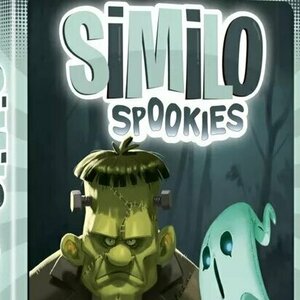
The Room
Games
App
Welcome to The Room, a physical puzzler, wrapped in a mystery game, inside a beautifully tactile 3D...
The room Puzzle Puzzler Atmospheric Clever games

Packing Pro
Travel and Productivity
App
** Featured in Apple's "10 Essentials," "Traveling Home" & "Staff Favorites" ** ** #1 Travel app in...

Hustle Sports Training Drills
Sports and Health & Fitness
App
Hustle offers basketball instruction from expert coaches and trainers. Whether you're looking for...

7 Wonders
Tabletop Game Watch
You are the leader of one of the 7 great cities of the Ancient World. Gather resources, develop...
BoardGames
BankofMarquis (1832 KP) rated Fantastic Beasts: The Secrets of Dumbledore (2022) in Movies
Apr 30, 2022
The 3rd installment of the Fantastic Beasts saga, THE SECRETS OF DUMBLEDORE is satisfying enough for fans of the ongoing Wizarding World of Harry Potter universe and will be time well spent for those of you that have watched all 8 Harry Potter films and the first 2 FANTASTIC BEASTS films, but it is nothing…magical.
Picking up where the 2nd film (THE CRIMES OF GRINDEWALD) left off, the arch-nemesis of Dumbledore (a game Jude Law) is in power and looking to start a war with the Muggles (non-magic folk). A ragtag group of heroes (are there any other kind) led by Newt Scamander (Eddie Redmayne) are humanity’s only hope.
And…while this worked well in the first series of film…this setup falls rather flat as it has a “been there done that” feel to it that is not really elevated above the ordinary.
The reason are numerous:
First, Newt Scamander is no Harry Potter. While Eddie Redymayne plays an interesting, quirky, central character - a character who’s unique skills were needed to defeat the bad guy in the first film - he is, really, a secondary character, yet he is the one we follow throughout the film. Kind of like watching the Harry Potter films through the eyes of Neville Longbottom.
Secondly, Grindewald (this time played by Mads Mikkelsen, replacing Johnny Depp) is no Voldemort. Grindewald was an interesting character set up in the first film, but by this film, he is pretty bland (and pretty blandly played by Mikkeslen who is, frankly, miscast).
Thirdly, Dumbledore (Jude Law in a very good performance, one that needed to be larger and more central) is sidelined for most of this film - a film about the battle between Grindewald and Dumbledore, a stumble (plotwise) to be sure in an awkward attempt to keeping the Newt Scamander character front and center.
Fortunately, the supporting cast is strong from Dan Fogler’s muggle, Jacob Kowalski to his love, Queenie (Alison Sudol) to Newt’s brother, Theseus (Callum Turner) to Newt’s assistant Bunty (Victoria Yeates) to Dumbledore’s brother, Aberforth (Richard Coyle) - all have their moments and are interesting (enough) to watch.
Unfortunately, Ezra Miller’s conflicted villain, Credence is poorly written with a crescendo to his character that lands with a thud. And, the inexplicable reason that Katherine Waterston’s main character of Tina is sidelined (rumors are she conflicted with J.K. Rowling) just doesn’t land, so, consequently, 2 major pieces from the first 2 films just don’t work.
What does work in this film is the magical sequences, as handled by Harry Potter veteran David Yates (who has now helmed 6 films in the Wizarding World franchise), the magical scenes are truly…magical. They are fun to watch and the real reason to watch this film, but the story is weak with a misguided viewpoint character that diminishes the fantasy for all.
Rumors are that this was supposed to be a 5 film franchise, but with box office diminishing for each successive Fantastic Beasts films, the filmmakers wisely decided to wrap up most storylines in this film.
It’s time to say goodbye to FANTASTIC BEASTS, but it should be time for the Wizarding World to go the way of Star Wars, Marvel and Star Trek - streaming TV series that breathes new life - and new, interesting characters - to a sagging franchise.
In the meantime, FANTASTIC BEASTS: THE SECRETS OF DUMBLEDORE is “good enough” and since it is all we have at the moment, it will have to do.
Letter Grade: B
7 stars (out of 10) - and you can take that to the Bank(ofMarquis)
Purple Phoenix Games (2266 KP) rated Canvas in Tabletop Games
Feb 3, 2021
Canvas is a game of card drafting and set collection in which players are trying to layer their cards to create unique pieces of artwork that will earn them Ribbons (VP) at the local art festival. To begin, set up the canvas mat, 4 random Scoring Cards, Ribbon tokens, and Art cards in their corresponding locations in the play area. Each player receives 3 sleeved Background cards and 4 Inspiration tokens. Select a starting player, and the game is ready to begin!
Playing over a series of rounds, players will take turns either Taking an Art Card or Completing a Painting. If you choose to Take an Art Card, you select an Art Card from the canvas mat and take it into your hand. The card furthest from the draw deck is free, but subsequent cards must be ‘purchased’ by spending Inspiration. Place 1 Inspiration token on every card preceding the one you take into hand. If you select an Art Card that has an Inspiration token on it, you collect that token for future use!
If you have at least 3 Art Cards, or a maximum of 5 Art Cards in hand, you must Complete a Painting. You will select 3 of your Art Cards to be sleeved with one of your starting Background cards. You may layer the Art Cards in any order you choose – but remember, only visible icons are used for scoring! Once you have Completed a Painting, you immediately score that piece. Compare the visible icons on your final painting to the Scoring Cards, taking any corresponding Ribbon tokens for successfully meeting their requirements. Play continues in this manner until all players have completed their 3 paintings. Players count up their cumulative scores from all paintings, and the player with the most points is the winner!
The gameplay seems simple enough, right? Yes! It is very straightforward since you only have 2 options for each turn. Either draft a card, or complete a painting. Teaching time is minimal and the gameplay can move quickly. But THAT is where the simplicity ends, my friends. The heart of Canvas is in its strategy. Each game has 4 random Scoring Cards, which define how you will earn points. And each transparent Art Card has a number of icons at the bottom that will affect how you resolve each Scoring Card. By layering your Art Cards, you will cover some icons, while letting others remain visible. The possibilities are truly endless when it comes to how to layer your cards, but are you clever enough to layer them for maximum points? Admittedly, the various layering possibilities coupled with 4 different Scoring Cards can lead to some analysis paralysis, as players try to figure out every combination they have to see what could earn the most points. But all in all, I have found the that the gameplay is never really at a standstill, because as one player is taking their turn, all others can be strategizing with their own cards.
Let’s talk about components. First off, I love the canvas mat – it really brings the theme to life and is good quality! The Art Cards are colorful and sturdy, and they really are clear enough to see even when layered upon each other. (I should say that I did remove the plastic film from the manufacturing process.) The Scoring and Background cards are nice, big, and easy to read and understand. My deluxe copy of Canvas has Wooden Ribbons and Inspiration tokens instead of the standard cardboard, and they are nice, chunky, and fun to play with. There are even 5 small wooden easels on which players can display their masterpieces! All in all, the deluxe components are great quality and really elevate the gameplay. AND the game box literally has a hole in the back so it can be hung on the wall, like a real piece of art! Such a creative and immersive approach to the game, that just puts a smile on my face.
If you’ve read this far in my review, I think you can tell that I really love Canvas. The theme is creative, the gameplay is simple, but extremely strategic, and the high quality components really make it feel deluxe. Is there anything I don’t like about it? Maybe that it makes my brain hurt sometimes when trying to figure out the best layering combo of my Art Cards. But seriously, this game is a new and unique twist on some of my favorite mechanics. Canvas is quickly making its way towards my Top 10 list, and this is one I will definitely be pulling out at game nights pretty often. Purple Phoenix Games gives this one an eccentric 11 / 12. Give it a shot, I don’t think you’ll be disappointed.
Purple Phoenix Games (2266 KP) rated Bob Ross: Art of Chill Game in Tabletop Games
Jun 30, 2021
Bob Ross: Art of Chill is a set collection, hand management, card drafting game that has its players attempting to complete masterful paintings before the master does in order to collect bonus “chill points” to win the game. Whomever manages to reach ultimate chill status will be victorious and can return to feeding Peapod, their rascally pocket squirrel.
To setup, place the easel and one of the shuffled painting panels upon it. Place the other panels (paintings) nearby. Place the main scoreboard nearby as well and place the shuffled Chill Cards on its space upon the board. The Technique Cards deck and the Art Supplies Card decks will be shuffled separately and placed below the board with four cards from each deck revealed as an offer. Place the Bob Mover (Bobeeple) on the easel in the first location printed on the panel. Each player will receive a palette, the scoring cube of their color to be placed on the scoreboard, the three Feature Markers, and three random Art Supplies Cards. The game may now begin!
On a turn players will be rolling the Bob die and carrying out its action. These actions are playing a paint card from hand onto their palette, drawing one Art Supplies Card from the deck to their hand, performing one free Action prior to the Action phase, or resolving the Bob die face. The Bob die face requires players to reveal a new Chill Card and resolve its immediate effects, or effects that will remain in play until a new Chill Card is revealed. Secondly, the Bobeeple will move to the next printed stopping point on the panel.
Once the die has been rolled and resolved, the active player will be able to take any three actions available in any order: Draw an Art Supplies Card (from the deck or from the offer), Sweep the Art Supplies Card (discard all face-up cards and reveal four new ones), Apply Paint to Your Palette (by placing it on your palette from your hand of cards), Wash Your Palette (by discarding cards from one of the palette areas to clear it), Earn a Technique Card (by discarding two like-cards from the hand of cards in order to score more VP for painting features in the future), or Paint a Feature (by discarding the required brush from the player’s hand of cards and the correct matching paints already applied to their palette).
Once complete, the next player will take their turn of rolling the die and completing three actions. Should players paint a feature on the panel before Bob moves to that spot on the panel the player(s) will gain extra bonus Chill points. Players may still paint features for points if Bob already has as well, they just will not receive the bonus Bob points. Turns will continue in this fashion until the moment one player has reached ultimate Chill and won the game.
Components. This game has a fair amount of components and I am happy to say they are all great! The cardboard components (palettes, score board) are good. The cards are all lovely linen-finished. The other player components are fine as well. The painting panels are excellent and feature actual Bob Ross masterpieces, and there are 15 double-sided panels in the box! The coolest component is certainly the easel though. It seems to be a somewhat real and functional easel (not that you would really want to paint on it) and it amps up the table appeal when setup and in play. I love the components and I am so glad that Big G Creative made a Bob Ross game with beautiful components. Anything less would be sacrilege.
It probably comes as no surprise that I love this game. I have always loved watching Bob Ross from when I was a child even up through my adulthood and I am relieved to be able to still watch him in action via Netflix. The game, though, is rather surprising. I certainly wasn’t expecting to like this as much as I do and was quite shocked to find out that there was actual substance in a Bob Ross game. Especially when it was stationed next to “games” like Who Wants to Be a Millionaire, Throw Throw Burrito, and the like. I enjoy the nostalgia in seeing my favorite colors in my hands like Phthalo Blue, Cadmium Orange, and Sap Green.
I don’t know if I would really consider this a gateway game, though I believe it really depends on the gamers with whom you are playing. There will be many times when you are concentrating on collecting the colors needed to finish a feature before Bob only to frustratingly never see that color on offer nor in the cards you draw and then the painting has to be refreshed because people can’t seem to stop rolling Bob on the die. However, if you play with people who can literally chill when things don’t go their way, this is a gem. Purple Phoenix Games gives Bob Ross: Art of Chill a 21 / 24. The only thing missing here is a way to, “beat the devil out of it,” and it would make my heart sing.
Purple Phoenix Games (2266 KP) rated Dreams of Tomorrow in Tabletop Games
Sep 17, 2020
Dreams of Tomorrow is game of set collection that utilizes a shifting rondel (I had to look up the definition too) in which players are working to weave a series of dreams into a complete Dream Sequence. Set in the future, players take on the roles of Dream Engineers, who are tasked with creating Dream Sequences to be sent to the past in an effort to save the future. Can you weave the most powerful Dream Sequence to alter the path of your present life, or is the future doomed to fall?
DISCLAIMER: We were provided a copy of this game for the purposes of this review. This is a retail copy of the game, so what you see in these photos is exactly what would be received in your box. I do not intend to cover every single rule included in the rulebook, but will describe the overall game flow and major rule set so that our readers may get a sense of how the game plays. For more in depth rules, you may purchase a copy online or from your FLGS. -L
To setup the game, place the Collective Consciousness (the rondel) in numerical order within reach of all players. Reveal a number of Dream cards from the Dream deck, based on the number of players, and these cards will create the communal Dreamscape. Each player receives a player card, cubes, and meeple in their chosen color, and sets their resources to the starting numbers, as described in the rulebook. All players begin with their meeples in the first space of the rondel, and in clockwise order, will select and pay for a Dream from the Dreamscape to be placed in their Dream Catcher (waiting area). Once all players have selected a Dream, and adjusted their resources accordingly, the game is ready to begin.
Dreams of Tomorrow is played over a series of rounds in which players will take turns performing 2 actions: Move and Take Action. Movement happens sequentially around the rondel, and players may choose how many spaces to move. To move 1-3 spaces is free, but to move more than 3 spaces will cost a number of resources. When a player decides to end their movement, they will then take the action indicated on the space on which they landed. These actions include: Gaining resources, Catching a Dream, Weaving a Dream, or Activating a Dream Ability. Gaining resources is pretty self-explanatory, and there is one neat thing to note: even if it is not your active turn, most of the rondel spaces have a Shared Effect, which grants an off-turn action to all non-active players. Catching a Dream means that you pay the requisite resources and select a Dream from the Dreamscape. Any caught Dreams go into your Dream Catcher until you are able to perform the Weave a Dream action. When you Weave a Dream, you again pay the requisite resources displayed on the Dream card and move the Dream from your Dream Catcher into your Dream Sequence (play area). To Activate a Dream Ability, you select a Dream card in your tableau, and use the ability printed on it. It is important to note that once Dreams are woven into your Dream Sequence, they will overlap each other, and only one Dream Ability will ever be available for use, so create that sequence wisely! Play continues in turns until one player has woven a Dream Sequence of five Dreams total. The round ends once all players have taken the same number of turns, and then final points are counted. The player with the highest score is the winner!
So all-in-all, how is Dreams of Tomorrow as a whole? I actually was very surprised at how much I enjoyed this game. When reading through the rules, it seemed kind of complicated and I was a bit worried before my first play. Once you actually get playing, however, the game is pretty intuitive and simple to play. One thing I particularly enjoyed about this game is its iconography. With only three resources and four actions, there are only seven icons of which to keep track. It keeps the cards from being cluttered with text, and makes the costs/abilities clear to understand. The iconography of the Dream Abilities, however, can be a liiiittle more complicated, but the game does come with Reference Cards which explain what every single icon means!
Another neat thing I enjoyed about this gameplay is the addition of Shared Effects. Even if you are not the active player, you will always gain some resource on everyone else’s turn. That adds an extra element of strategy because you have to amass your own resources for Dreams, but you have to be careful not to be giving your opponents too much extra help for themselves! Probably my favorite part of Dreams of Tomorrow are the actual Dream Abilities themselves. Performing the regular turn actions are pretty straight-forward, but Dream Abilities are more special and allow you to do even more on your turn. For example, some Dream Abilities allow you to change directions, move extra spaces, or even alter the Collective Consciousness, re-arranging the cards in a way to benefit you and hopefully hinder your opponents. The Dream Abilities are literal game-changers, and they really keep all players on their toes.
Talking about components, this game is of a pretty good quality. The cards are nice and sturdy, the player boards are decent, and the meeples and cubes are your standard wooden tokens. I’ve said in reviews before, but I always appreciate when games include Reference Cards for players, and Dreams of Tomorrow certainly delivered on theirs. The cards are clear, concise, and helpful during play. The artwork of this game is very vibrantly colorful and just plain pretty to look at. I found myself getting distracted by admiring the artwork, or catching Dreams based on their artwork, instead of taking their point-values or resources requirements into consideration. Oops. That’s just my bad, but the artwork really helps make the game more immersive.
Overall, I would say that Dreams of Tomorrow is a great little game. Admittedly, the rulebook is kind of daunting and seems a little overly complicated at first, but once you get into an actual game, it flows very quickly and easily. After just one turn, I got exactly what was happening and had no further questions about the gameplay. It really went above and beyond my expectations, and is one that I definitely look forward to bringing out in future game nights. Purple Phoenix Games gives it a dreamy 10 / 12. Check this one out if you haven’t before, it may just be the game of your dreams. (Ha, get it?)
Bob Mann (459 KP) rated Ad Astra (2019) in Movies
Sep 28, 2021
I really love sci-fi films with high ambitions. “Psychological” sci-fi like “Solaris” for example. And “Arrival” topped my movie list for 2016. In similar vein, “Ad Astra” is also a movie concerning attempted contact with alien life. So I had high hopes for it. But would this Sci-fi epic ultimately challenge my brain again, or end up in the “Crystal Skull” sin bin with a dodgy alien meeting?
The Plot
Set a few years into the future, Roy McBride (Brad Pitt) is the son of a legend. H. Clifford McBride (Tommy Lee Jones) was a space exploration pioneer. His picture hangs in the NASA hall of fame next to Buzz Aldrin’s. McBride senior went missing presumed dead near Neptune during a mission. The mission was to get outside the Sun’s heliosphere to scan for potential alien transmissions from nearby solar systems.
But something went badly wrong, and now the earth (and potentially all human life migrating into the solar system) is at risk from massive electromagnetic bursts arising from Neptune. Is Clifford alive and involved in the emerging crisis? The authorities send Roy on a secret mission to Mars to try to communicate with his father.
Majestic cinematography
Let’s start with a real positive. The cinematography here is first rate. Hoyte Van-Hoytema – well known for “Interstellar“, “Spectre” and “Dunkirk” – knocks this out of the park. In the same manner as “Blade Runner 2049“, many of the frames of this film could be blown up and placed on art gallery walls around the world.
Add to that some cracking film editing from John Axelrad and Lee Haugen, and some beautiful sound design and I predict the movie should feature strongly in the technical awards at the Oscars.
But “science fiction” has the word “science” in it….
I’d like to park my physics brain sometimes when I go to the movies, but I just can’t. So I really need sci-fi films to live up to the science part of their name. There are a number of areas, particularly at the back end of the film, when credibility goes out the window.
I can’t really say more here without giving spoilers, so I will leave them to a “Spoiler section” below the trailer…. don’t read this if you haven’t seen the film!
What IS this movie trying to be?
In my view the film is pretty schizophrenic in nature. This is what confused me about the trailer, jumping from a cerebral sci-fi vibe to moon buggy shoot-outs.
On one hand, its the standard (but always interesting) tale of a child abandoned by a hero-father and his attempts to reconcile what that’s done to his life and relationships. How can he ever square that circle without contacting his dad? As the film’s tag-line goes “The answers we seek are just outside our reach”.
On the other there are episodes of action that would fit happily into an action scene from Star Trek.
The two elements never really gel, leading to the feeling of the film having been written as a set of disconnected pages and the writers then saying “Hey, Jimmy, once you’ve finished making us the tea, could you just write a few lines to join those pages up into a shooting script?”. Then later, “What do you mean Jimmy you used BOTH piles of paper?!”.
The greatest sin of all
Unfortunately, the film commits a cardinal sin in my book. Those of you who follow my blog regularly might know what I’m going to say….
Voiceovers! I BLOODY HATE THEM!! It’s at the very extreme of what the great Mark Kermode calls “show don’t tell”.
Here, we don’t just have a little Brad Pitt set-up intro and he then shuts up. He just drones on and on and on with his inner thoughts. At least Matt Damon in “The Martian” got away with it by cleverly filming his video blog. And it’s not as if there isn’t a prime opportunity to use that device here! He is constantly having to talk to a computer to do his regular psychological tests! But that option is not picked up.
BIG BLACK MARK!
But the film has its moments
Bubbling under all of this are some stand-out moments where, for me, the film soared. One of them (ultimately setting me up for as much of a disappointing fall as some of the characters!) is the stunning opening shots aboard the “Sky Antenna” structure. Impressive and exciting, with falling bits of metal playing Russian Roulette with Roy’s iife.
Another strength for me is Brad Pitt. I’ve seen wildly differing views on this, but for me its a quiet but strong acting performance. There are many scenes when he has no lines, his inner (and our outer) voice gives it a miss, and he acts the socks off his peers. What with “Once Upon A Time… In Hollywood” its been a really good year for Pitt. I suspect “Hollywood” might be the one though that gets him his fourth acting Oscar nomination.
For a 2019 film, it’s actually a very male-heavy film, made more so by Pitt’s love-interest (Liv Tyler) being given virtually nothing to do other that look a bit sulky from a distance. I’m not even sure she gets a single line in the whole film! (“Miss Tyler – please sign for your script”. “But, there’s nothing in the envelope?”. “Quite Miss Tyler, Quite”).
The only decent female role goes to Ruth Negga as the Mars colony leader. Even then, she only has limited screen time and although having the title “Mars CEO” really doesn’t seem to have much power.
Elsewhere, its great to see both Tommy Lee Jones and Donald Sutherland back on the big screen again.
Final Thoughts
As any veteran RAF person will know, “Ad Astra” is Latin for “To the stars”. In space terms this is less “to the stars” and more “just beyond your front door”.
James Gray‘s film undoubtedly has high ambitions but, through its spasmodic script, never really gets there. It has the beauty of “Gravity” but none of the refinement; there’s an essence of “Space Odyssey” in places, but it never goes for the mystical angle; it has the potential to reflect the near-insanity through loneliness of “Silent Running” but never commits fully to that storyline. But if its novelty you’re looking for, it ticks the “floating monkeys in space” box!
I think it’s worth seeing on the big screen just for its visual beauty and Pitt’s performance. And as a major block-buster sci-fi film I enjoyed it to a degree. But for me it had just so many irritations that it failed to live up to my high expectations. A great shame and a frustrating disappointment.
But at least it’s great news for Richard Branson and Virgin Atlantic shareholders. They can be assured that the future is bright for their “long distance” flights in the future!
Purple Phoenix Games (2266 KP) rated Similo: Spookies in Tabletop Games
Mar 11, 2022
Similo: Spookies (which I will just call Similo from here on out, as they are all basically the same, but with different themes) is a party card game where one player knows information and attempts to persuade the other players to choose the correct character SILENTLY. One game lasts five rounds or less, and many times players will want to play multiple games in a row.
To setup, shuffle the deck of cards and place it face-down on the table. The player chosen to be the “Clue Giver” will then secretly look at the top card. This card will be the secret character for the entire game. Along with this card, the Clue Giver will draw an additional 11 cards and shuffle them. Next, lay out the 12 characters face-up in a 4×3 grid, so that all players can see. Finally, the Clue Giver draws another five cards to act as their starting hand of clues. The game may now begin in earnest!
The game lasts no more than five rounds, and each round is played mostly the same. During the first round the Clue Giver will place a card from their hand onto the table in either Portrait or Landscape mode (I know there are different words to describe these orientations, but they are failing me now). When a card is in Portrait mode, the Clue Giver is letting the players know that the secret character has similarities to the played card. Landscape placement means that the secret character has differences from the card played.
At the end of the first round, the other players must discuss and decide one card from the grid to remove from play, based on the Clue Giver’s information. If the card removed is the secret character (or at any time the secret character is removed in this way) the players all immediately lose the game. However, if the players have removed an appropriate character card, then the game moves to the second round. Each subsequent round is played exactly the same way, except the number of cards removed will match the round number being played. For example, during the third round three cards will be removed. The only exception here is the very last fifth round. During this round there will only be two cards remaining, and the players will need to choose the correct one to win the game. Win or lose, all players will most likely request to play another game with a different Clue Giver.
Components. This game is 30 cards in a tuckbox. The cards are all great quality with excellent linen finish. They each have the character’s name on the upper left corner and a small thematic quip on the lower right corner. The big thing here is the utterly amazing character art by Naiade (Seasons, Tokaido, Isla Dorada, etc). They are each so wonderfully illustrated, and they have to be, considering the entire game is based on the similarity or differences of each card. I was so very pleasantly surprised to see this beautiful set of cards pop out of the box when I opened it. Zero issues with components here.
This game is low-key a thinking person’s puzzle. How can I get the group to exclude one card specifically and throw away all the others? What the heck is this Clue Giver trying to tell us? What exactly is an Oni? With the right group of gamers, especially those that share many inside jokes and experiences, this could be a nightly hit. Now, determining the difference between Frankenstein’s Monster and a Zombie may be harder than you thought, so do be careful with those technicalities.
This one really reminds me of a much more compact version of Deception: Murder in Hong Kong. There is a silent Clue Giver in both trying to guide the other players to the right answer using cards. If I can get the same feeling from a game featuring 30 cards versus about 300 I might have a replacement situation on my hands here.
For its tiny table presence, excellent artwork, and overall game play, Purple Phoenix Games gives this one a bone-chilling 4 / 6. I know at this very second that my score is hanging in the balance. I want it to be a 5 so very badly, and I feel that it may actually get there, assuming I can play with larger groups of people and a variety of types of gamers. For now, I am happy with the 4 it is assigned. If you are like me and didn’t know you needed a smaller game in your collection that can give similo experiences to bigger boxes, give this one a shot.
Oh PS – You can also combine the different sets into a larger and more chaotic game. I’m not sure I have the huevos for that quite yet, but I think a good counterpart to this Halloween-themed set may be the Fables or Myths sets. Let me know if you have combined these two and if my hunch is correct. I’m going to go fanboy over Naiade’s art now.





